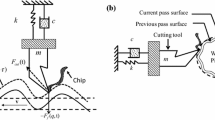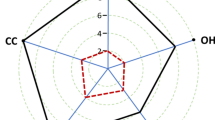Abstract
This paper presents a new technique to evaluate the stable cutting zone with enhanced metal removal rate in turning operation. Experiments have been conducted at various levels of cutting parameters: depth of cut, feed rate, and spindle speed. Acquired raw chatter signals have been preprocessed using wavelet transforms in order to remove the ambient noise contents. Response surface methodology has been adopted to develop mathematical models of chatter severity and metal removal rate (MRR). Further, multi-objective genetic algorithm technique has been invoked in order to establish the stable cutting zones with maximized MRR. Good correlation between the predicted and experimental results validates the developed technique of ascertaining tool chatter severity and metal removal rate.

































Similar content being viewed by others
References
Abouelatta OB, Madl J (2001) Surface roughness prediction based on cutting parameters and tool vibrations in turning operations. J Mater Process Technol 118(1–3):269–277
Bartarya G, Choudhury SK (2012) Effect of cutting parameters on cutting force and surface roughness during finish hard turning AISI52100 grade steel. Procedia CIrP 1:651–656
Bayly PV, Metzler SA, Schaut AJ, Young KA (2001) Theory of torsional chatter in twist drills: model, stability analysis and composition to test. J Manuf Sci Eng 123:552–561
Budak E, Tekeli A (2005) Maximizing chatter free material removal rate in milling through optimal selection of axial and radial depth of cut pairs. CIRP Ann Manuf Technol 54(1):353–356
Chabbi A, Yallese MA, Meddour I, Nouioua M, Mabrouki T, Girardin F (2017) Predictive modeling and multi-response optimization of technological parameters in turning of polyoxymethylene polymer (POMC) using RSM and desirability function. Measurement 95:99–115
Clancy BE, Shin YC (2002) A comprehensive chatter prediction model for face turning operation including tool wear effect. Int J Mach Tools Manuf 42:1035–1044
Debnath L (2003) Wavelets and signal processing. Birkhauser, Boston
Hashmi KH, Zakria G, Raza MB, Khalil S (2016) Optimization of process parameters for high speed machining of Ti-6Al-4 V using response surface methodology. Int J Adv Manuf Technol 85(5–8):1847–1856
Kuljanic E, Sortino M, Totis G (2008) Multisensor approaches for chatter detection in milling. J Sound Vib 312(4):672–693
Kumar S, Meenu, Satsangi PS (2013) Multiple-response optimization of turning machining by the Taguchi method and the utility concept using uni-directional glass fiber-reinforced plastic composite and carbide (k10) cutting tool. J Mech Sci Technol 27(9):2829–2837
Montgomery DC (2009) Design and analysis of experiments. Wiley, New York
Paiva AP, Ferreira JR, Balestrassi PP (2007) A multivariate hybrid approach applied to AISI 52100 hardened steel turning optimization. J Mater Process Technol 189(1):26–35
Quintana G, Ciurana J (2011) Chatter in machining process: a review. Int J Mach Tool Manuf 51:363–376
Sastry S, Kapoor SG, DeVor RE (2002) Floquet theory based approach for stability analysis of the variable speed face-milling process. J Manuf Sci Eng 124:10–17
Siddhpura M, Paurobally R (2012) A review of chatter vibration research in turning. Int J Mach Tools Manuf 61:27–47
Sun H, Zhang X, Wang J (2016) Online machining chatter forecast based on improved local mean decomposition. Int J Adv Manuf Technol 84(5–8):1045–1056
Tang WX et al (2009) Prediction of chatter stability in high-speed finishing end milling considering multi-mode dynamics. J Mater Process Technol 209(5):2585–2591
Tansel IN, Wang X, Chen P, Yenilmez A, Ozcelik B (2006) Transformations in machining. Part 2. Evaluation of machining quality and detection of chatter in turning by using s-transformation. Int J Mach Tools Manuf 46(1):43–50
Taylor CM, Turner S, Sims ND (2010) Chatter, process damping, and chip segmentation in turning: a signal processing approach. J Sound Vib 329:4922–4935
Tekeli A, Budak E (2005) Maximization of chatter-free material removal rate in end milling using analytical methods. Mach Sci Technol 9(2):147–167
Toh CK (2004) Vibration analysis in high speed rough and finish milling hardened steel. J Sound Vib 278(1):101–115
Wang L, Liang M (2009) Chatter detection based on probability distribution of wavelet modulus maxima. Robot Comput Integr Manuf 25:989–998
Yao Z, Mei D, Chen Z (2010) On-line chatter detection and identification based on wavelet and support vector machine. J Mater Process Technol 210(5):713–719
Zhang L, Wang X, Liu S (2012) Analysis of dynamic stability in a turning process based on a 2-DoFs model with overlap factor. J Mech Sci Technol 26:1891–1899
Acknowledgements
The authors gratefully acknowledge the Mechanical Engineering Department, IIT Indore, India for their help in conducting experiments.
Author information
Authors and Affiliations
Corresponding author
Rights and permissions
About this article
Cite this article
Kumar, S., Singh, B. Stable Cutting Zone with Improved Metal Removal Rate in Turning Process. Iran J Sci Technol Trans Mech Eng 44, 129–147 (2020). https://doi.org/10.1007/s40997-018-0253-y
Received:
Accepted:
Published:
Issue Date:
DOI: https://doi.org/10.1007/s40997-018-0253-y




